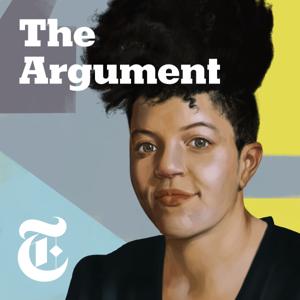
Sign up to save your podcasts
Or




Book banning has surged in America’s classrooms. The free speech advocacy organization PEN America has compiled a list of more than 1,500 reported instances of books being banned in public schools and libraries in less than a year. As students head back to school, what are the books we do and don’t want our kids to read? And what are the values America’s students are meant to take away from the pages of books?
So on this episode of “The Argument,” Jane Coaston is talking to two writers and teachers to figure out what high school English syllabuses should look like in 2022. Kaitlyn Greenidge is a contributing Opinion writer and novelist who has taught high school English and creative writing, and designed English curriculums for for-profit companies. Esau McCaulley, also a contributing Opinion writer, is an associate professor at Wheaton College.
Greenidge argues that at their best, English classes and the books read in them should be a place to find mutual understanding. “When you’re talking about what we should read in English class, you’re really talking about how to make a common language for people to talk across,” Greenidge says. But the question of whose stories are included in that common language — especially when it comes to what makes up the Western canon — is especially fraught. And to McCaulley, how teachers put a book in context is just as important as what their students are reading in the first place. “That’s what makes discussions around the canon complicated,” he says. "Because the teacher has to be able to see these texts as both powerful and profoundly broken, because they’re written by humans who often have those contradictions in themselves.”
Mentioned in this episode:
(A full transcript of the episode will be available midday on the Times website.)
Unlock full access to New York Times podcasts and explore everything from politics to pop culture. Subscribe today at nytimes.com/podcasts or on Apple Podcasts and Spotify.
 View all episodes
View all episodes


 By New York Times Opinion
By New York Times Opinion




2.8
2020 ratings

Book banning has surged in America’s classrooms. The free speech advocacy organization PEN America has compiled a list of more than 1,500 reported instances of books being banned in public schools and libraries in less than a year. As students head back to school, what are the books we do and don’t want our kids to read? And what are the values America’s students are meant to take away from the pages of books?
So on this episode of “The Argument,” Jane Coaston is talking to two writers and teachers to figure out what high school English syllabuses should look like in 2022. Kaitlyn Greenidge is a contributing Opinion writer and novelist who has taught high school English and creative writing, and designed English curriculums for for-profit companies. Esau McCaulley, also a contributing Opinion writer, is an associate professor at Wheaton College.
Greenidge argues that at their best, English classes and the books read in them should be a place to find mutual understanding. “When you’re talking about what we should read in English class, you’re really talking about how to make a common language for people to talk across,” Greenidge says. But the question of whose stories are included in that common language — especially when it comes to what makes up the Western canon — is especially fraught. And to McCaulley, how teachers put a book in context is just as important as what their students are reading in the first place. “That’s what makes discussions around the canon complicated,” he says. "Because the teacher has to be able to see these texts as both powerful and profoundly broken, because they’re written by humans who often have those contradictions in themselves.”
Mentioned in this episode:
(A full transcript of the episode will be available midday on the Times website.)
Unlock full access to New York Times podcasts and explore everything from politics to pop culture. Subscribe today at nytimes.com/podcasts or on Apple Podcasts and Spotify.

3,851 Listeners

1,454 Listeners

3,903 Listeners

6,639 Listeners

8,842 Listeners

130 Listeners

2,064 Listeners

110,824 Listeners

1,498 Listeners

12,625 Listeners

303 Listeners

6,926 Listeners

5,408 Listeners

469 Listeners

52 Listeners

2,320 Listeners

380 Listeners

1,451 Listeners

6,672 Listeners

5,437 Listeners

15,363 Listeners

1,493 Listeners

1,478 Listeners

7 Listeners

66 Listeners

10 Listeners

513 Listeners

452 Listeners

0 Listeners

50 Listeners